The Rickmansworth Fire Brigade
The story from 1869 to 1945
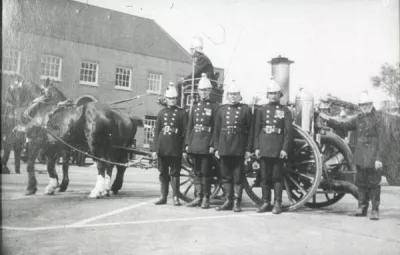
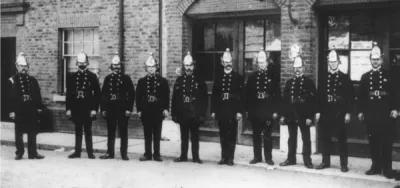
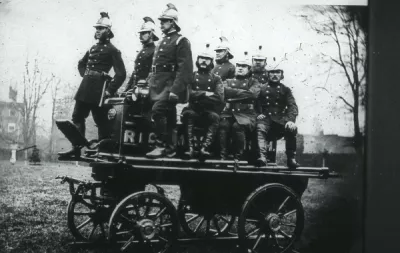
From relatively early in the eighteenth century fire 'services' were funded by the insurance companies - to provide some cover for their liabilities! But during the nineteenth century parish authorities began to make some public provision - Berkhamsted was one, Rickmansworth another.
In Rickmansworth, it was Dr R W Henderson (1841 – 1929) who in 1869 founded and led the Volunteer Fire Brigade. The material we have in the museum is summarised here.
In that year a fire in the High Street was attended by the old parish fire engine with a group of onlookers helping as best they could. Dr Roderick Henderson, already a doctor in the town and to be described in the 1871 census as ‘General Practitioner’ living at 191 High Street, had been a volunteer helper (‘runner’) in London as a medical student at Guy’s Hospital, attending many London fires, and remained interested in fire fighting for the rest of his life. Following the High Street fire he suggested to the parish that a properly trained body of men be recruited to fight fires quickly and efficiently with a sound knowledge of their equipment and able to maintain it properly. Acting on this a group of townspeople formed a committee, and called a meeting in the town hall at which it was resolved that a Fire Brigade should indeed be formed, paid for by public subscription; and his interest in and knowledge of the matter made Dr Henderson himself the obvious choice to form and train the newly-formed brigade. So, as reported in the Watford Observer in late 1870, the brigade was formed and and the old fire engine handed over and housed in a building nearby. Herbert Fellows, the brewery manager, was the first Captain (and paid for that first fire station), but Roderick Henderson was the driving force and became Captain shortly after.
The development of fire-fighting equipment led the Committee, encouraged and to an large extent funded by Dr Henderson, to build a new Fire Station at 181 High Street in 1891, when they also got a steam-powered (but horse drawn) engine, with a long ladder added in 1897. The building was let to the Brigade at £8 per week and still stands, with an inscribed stone bearing the names of Dr Henderson and other members of the volunteer crew when it was opened. In 2001 Cllr Barbara Lamb undertook a considerable research to identify fully the firemen listed on that 1891 stone, and that information is in a folder in the museum (it has been stated that these were the ‘original’ firemen, but of course they were the successors of the 1869 crew, whose names we do not [yet] know).
They were, in 1891,
- Roderick W Henderson of Basing House.
- Thomas Holland, a builder living in the High Street.
- W Williamson, ironmonger, also in the High Street.
- Stephen Beeson, the ironmonger and hardware dealer with his shop in Church Street, also resident in the High Street.
- Harry Barton, dairyman, living in Station Road but with his business in the High Street.
- James Fowler, publican of the Coach and Horses. But another J Fowler was a tailor, also in the High Street, and it seems possible that they were the same.
- George Graham, saddler of the High Street.
- Herbert Collis, manager of the boot 'warehouse' in the High Street.
- Alfred Wright, butcher, living in Church Street.
- Sidney Large, a single man and landlord of the Swan Inn, High Street.
- Mungo Patterson, draper, High Street. He became ill and died aged 39 after a fire, and was buried with his helmet and hatchet.
- James Scully, the manager of Salters Brewery, resident in Brewery House, High Street.
- William Swannell, Chief Engineer. Born in 1864, so only 27 in 1891, was an auctioneer and estate agent, in 1901 living with his widowed mother, sister and brother in law at Nuttfield, Croxley Green.
Several of these men will be in the 1901 photograph above.
Roderick Henderson continued to lead, and support financially, the fire brigade until it was taken over by the UDC in 1925, when he was already 84. In 1902 the Rickmansworth brigade set up a ‘branch’ at Northwood, which was matched by the establishment of a dedicated Northwood brigade. Two brigades were clearly not needed (evidence at the Northwood end suggests that the Rickmansworth end was rather tetchy about it), but amalgamation proved difficult, and eventually Rickmansworth’s brigade continued on a local basis, although still covering a wide area.
The public subscriptions were recorded
and published in the annual report, for example the one by Dr Henderson as Chief Officer in 1912 (see below), and it's clear that he was himself a generous benefactor. We can see that subscriptions were taken not only from the town, Mill End, Batchworth
and West Hyde, but also from Sarratt, Chipperfield, Chorleywood,
Harefield, Moor Park (note Lord Ebury's generous contribution),
Heronsgate and Chalfont. The response to a fire was wide-ranging - and
of course, fire at this time was a very frequent event, often fatal.
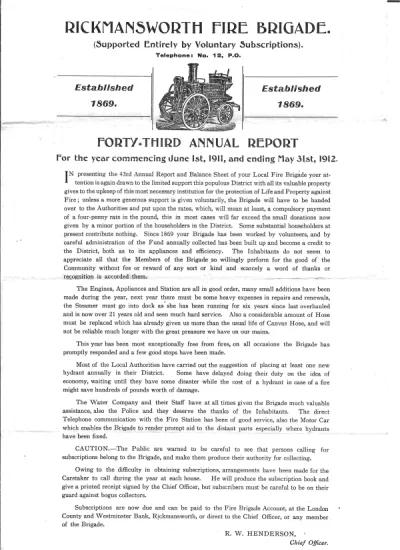
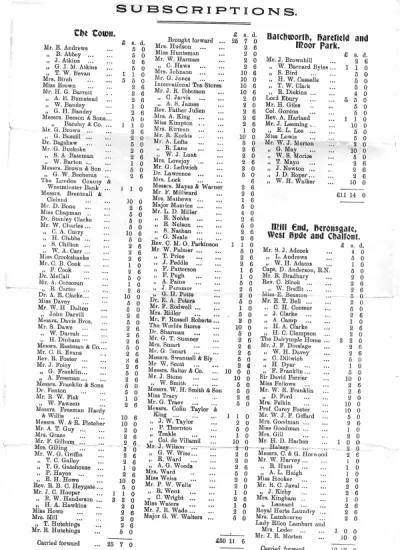
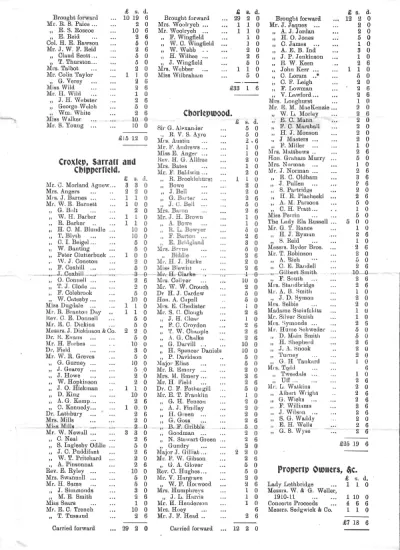
The 1891 fire engine remained, horse-drawn, until 1927 (after Rickmansworth Urban District Council had taken over the Fire Brigade in 1925) by a modern Dennis fire engine. That fire engine took part in Dr Henderson's funeral procession in 1930, and is seen below.
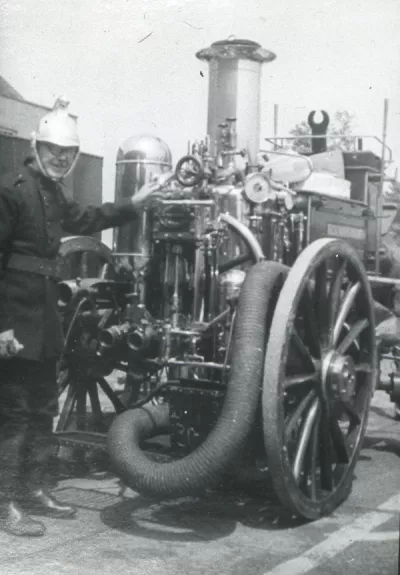
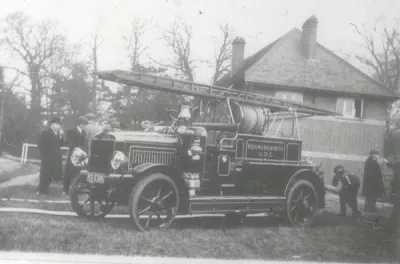
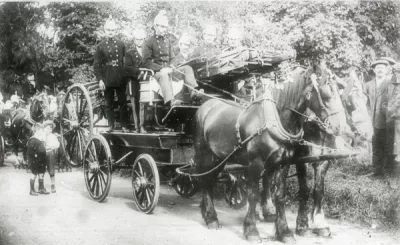
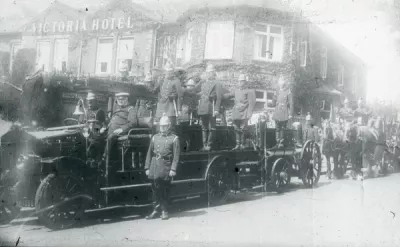
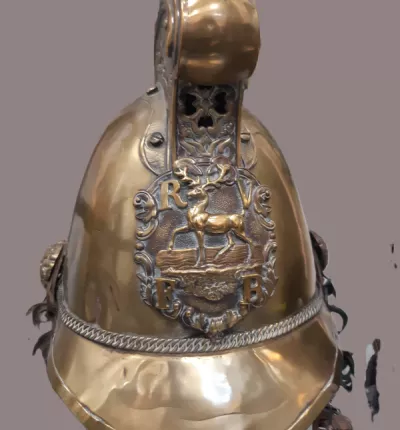
One of the firemen of that time was Mr Cecil (‘Jo’ ) Hall, a Londoner and the grandfather of a correspondent from Australia, who joined in 1913. ‘Jo’ Hall had married a London girl, Florence, in late 1913 having already moved to Rickmansworth, and was to fight in WW1 in the 16th Hussars. There is a suggestion in family papers that they lived for a time in a flat above the fire station in the High Street, but Rectory Road and Wensum Cottages are also likely homes. He will almost certainly have taken part in Dr Henderson's funeral procession, and when their son Harry, born early in the War, was married in 1938 the fire engine served as the ‘bridal carriage’: Harry was also a volunteer fireman most of his adult life (it was a full time “reserved occupation” throughout WWII) - the brass “call bell” was set under the stairs of the family home in West Way, and needless to say, was very much part of the family’s life both day and night.
Fire Brigades were still very local until 1938, when the Fire Services Act combined the functions of 185 fire brigades and imposed fire-fighting duties upon local authorities – the functions of remaining parish fire brigades were to be transferred to Rural District Councils, which Rickmansworth had pre-empted.[1] In 1941 they were brought together formally to form the National Fire Service with County Councils responsible for them. The 1939 Register has Mr Hall sr as the Fire Station Officer at Rickmansworth, and he died at the fire station having returned from a fire in November 1944.
The fire station moved up to Rectory Road, with the police (and ambulance) when the road was widened in 1972 - the police station, originally in Talbot Road, had moved near the new fire station in 1891.
The national records are in the National Archives at Kew. The summary of the national story up to 1945 is quoted in the summary page of the Discovery website thus:
The responsibility of the Home Office for fire services stemmed partly from the common practice, especially in boroughs, of administering fire brigades as part of the police establishment and partly from its concern with and experience of questions of safety and explosives. The Home Secretary was responsible for approving the provision of fire brigades under the Public Health Act 1907, and during the First World War had powers under defence regulations to establish schemes of co-ordination between fire brigades against aerial attack. These powers lapsed at the end of the war, and the remaining work in connection with fire prevention and fire brigades was dealt with by the Police Division. The Royal Commission on Fire Brigades of 1923 recommended that the Home Office should become the central fire authority for certain purposes, but this was not implemented until 1938. The Local Government Divisions of the Ministry of Health were also concerned.
The Fire Brigades Act 1938 made county boroughs, boroughs, urban districts and rural districts responsible for the provision of an adequate and efficient fire service and invested the Home Secretary with powers of direction, assisted by a Fire Service Commission and a Central Advisory Council. In May 1941 the Home Secretary established a National Fire Service maintained by the national exchequer, and a Fire Service Council composed of officials. At the same time the Fire Brigades Division (K Division), which had been set up in 1936 to supervise the consolidation of fire services, was renamed the Fire Service Department and took charge of the introduction of the National Fire Service. It was divided into two branches, Branch A dealing with peace time fire organisation and general policy and Branch B with emergency fire brigade organisation and supply programmes. Technical assistance was provided by professional fire staff and an inspectorate.
A Home Office Fire Control was established to maintain contact with a regional organisation and to control inter-regional assistance. Until 1941 the regional organisation was based on the delegation of powers to the regional commissioners of the civil defence regions, but thereafter each commissioner was assisted by a chief regional fire officer. Regions were divided after the establishment of the National Fire Service into fire forces under fire force commanders. A regional inspectorate of regional fire offices and fire force commanders was also established.
Many of the records covering the National Fire Service have reference HO 187, with the personnel records, including the Roll of Honour, in HO 187/1086, which covers 1940 to 1947 and has not been digitised.
[1] The National Archives HO187/5